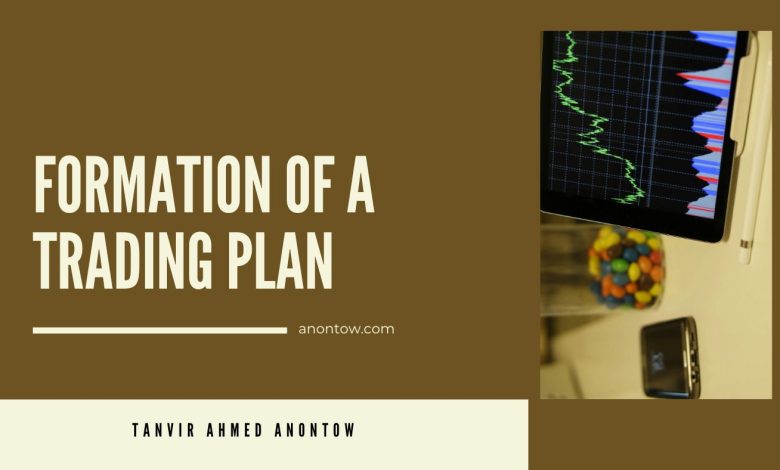FORMATION OF A TRADING PLAN
A day trader may have a rule to stop trading if they lose three trades in a row, or lose a set amount of money.

FORMATION OF A TRADING PLAN
Do you sometimes lose sight of your trading possibilities and feel confused in the market? Many traders are always changing horizons, looking for signs, and chasing the price, which causes them to miss out on profitable trades.
A trading plan is essentially a road map for someone looking to acquire and sell investments such as stocks or FX.
- Reactive trading strategies like these not only sap your energy but also often result in emotionally charged trading errors like price chasing, vengeance trading, and overtrading. Reactive traders frequently experience tiredness and discouragement at the conclusion of a trading week after not achieving the desired level of trading performance.
- In contrast, proactive traders constantly position their transactions in the appropriate context and predict price moves based on sound analysis. Prosperous traders usually strategize their trading session beforehand and merely carry out their plan. This approach is less demanding and typically yields more reliable outcomes.
- Use a trading plan if you want to become a more proactive trader. Following a plan will help you stay disciplined, reduce rash decisions, and make trading decisions that are in accordance with the general market conditions. All of these things will help you handle trading in a more methodical and impartial manner.
| Feature | Planned Trading | Unplanned Trading |
|---|---|---|
| Approach | Disciplined, research-based | Reactive, impulsive |
| Risk Management | Defined stop-loss and take-profit levels | Uncontrolled risk exposure |
| Emotional Control | Reduces emotional influence on decisions | Prone to fear and greed-driven choices |
| Performance | Statistically tends towards better returns | Higher potential for losses |
Here are some reputable resources that can help you get started:
Free Resources:
- Investopedia: https://www.investopedia.com/terms/t/trading-plan.asp offers a good starting point with articles and guides on creating a trading plan.
- FINRA (Financial Industry Regulatory Authority): https://www.finra.org/about/finra-360/progress-report/investor-education-tools provides educational resources on various investment topics, including developing a trading strategy.
- Securities and Exchange Commission (SEC): https://www.sec.gov/investor/alerts has resources on protecting yourself from fraud and making informed investment decisions.
Paid Resources:
- Online Courses: Platforms like Udemy or Coursera offer courses on trading strategies and plan development. Look for reputable instructors with experience in your preferred trading style.
- Trading Books: Many well-regarded books discuss trading plans. Popular options include “Trading in the Zone” by Mark Douglas or “The Trading Book” by Anne Warner.
- Financial Advisors: A fee-based financial advisor can help you develop a personalized trading plan aligned with your risk tolerance and goals.

AN ENTRY IS NOT ALL THAT A TRADE IS.
Most traders will only discuss how they locate trade entries and the signals they utilize to define an entry when you question them about their trading approach. Furthermore, selecting the ideal entry price is only one component of a comprehensive trading strategy; it is by no means sufficient on its own.In order to construct a comprehensive trading strategy, traders must specify the general idea behind the strategy, develop guidelines for placing stops and targets, have a clear understanding of how to handle their trades, and have a consistent approach to risk management. Increasing trading consistency is the aim of developing a comprehensive trading strategy aims to increase trading consistency. Trading results are consistent when you make consistent trading judgments. Your trading strategy is the foundation of a trading plan, which optimizes your trading by directing your daily decision-making.
Read More: How to Trade Forex on News Releases
THE ESSENTIALS OF A TRADING PLAN: 5

Let’s look at the various parts of a trading plan and see how they might help you trade more profitably and create a stress-free atmosphere. Although there are many ways to create trading plans, most traders should be able to use the framework provided here.
1. OVERALL CONTEXT OF CHART
Usually, the price analysis begins with the higher period in order to identify the trend environment and gain a general understanding of the chart context.
The daily timeframe is a popular choice among traders as their higher timeframe. Although traders can enter trades on the 1H or 30min timeframes, which are not typically thought of as day trading timeframes, they can also use the daily period as a good alternative as a higher timeframe for day traders. On a longer timescale, you can see the overall trend direction. Because trading into the higher timeframe’s trend direction is often seen as a better trading strategy, this aids in trade selection.
Read More: How to Trade Forex on News Releases
The daily timeframe’s levels of support and resistance are more significant. Consequently, before moving on to the lower period, traders should first draw their price levels on their upper timeframes. During the daily period, significant round numbers can be found and prior supply and demand zones can be drawn.
According to the trend analysis, finding bullish trading opportunities in the lower timeframe would better fit into the overall trend context. Trading with a bearish outlook would not be logical given the current higher-timeframe scenario. The trend analysis on higher timeframes serves as an initial filter for trade direction.
The resistance levels at the top are something that bullish traders should be aware of since they may serve as target levels for possible bullish trading opportunities that a trader may come across in the lower timeframes.
2. IDENTIFICATION SET-UP
It is often not advisable to enter long trades without first conducting a lower timeframe analysis, even though a higher timeframe indicates an overall favorable trend environment.
Traders search for particular entry requirements in the lower timeframe and build a trading strategy around the rules of the approach they have selected. A trader has an infinite array of trading strategies at their disposal. The purpose of this article is to illustrate the overall methodology of a top-down trading plan technique, rather than advocate for any particular trading strategy.For this article, we can use the standard pullback trend-following technique. Additionally, a trader waits for the price to move lower in order to provide a better entry point rather than jumping into a long trade based on the daily timeframe analysis right away.
The 5-minute span is displayed in the screenshot below. The pullback trader waits for the price to return to the daily pivot point (purple line) rather than chasing the bullish trend on the daily timeframe, and then displays a chart pattern that can be employed for breakout trades.Trading plans usually have an if-then structure. The trader is waiting for a specific event on the price chart, which is described in the “if” section, and the trader’s planned response is described in the “then” part.
3. TRADE PARAMETERS: TRADE MANAGEMENT, TARGETS, AND STOP LOSS
The trader now has to put stops and take profits in accordance with the trading plan guidelines. The majority of traders ignore other aspects of their trading approach in favor of fixating on the ideal entry.
Target placement and stop losses are essential components of a successful trading strategy. Your winrate and the length of time you hold your trades are directly impacted by your stop and target. Both are essential indicators for a trading plan.
While elucidating the trade parameter relationship is not the aim of this paper, the following brief digression might be useful: It is more difficult for the price to hit the stop-loss level the further the stop-loss is from the entry. Conversely, a closer stop loss makes it simpler to hit the price and, as a result, lowers the winrate. Winrate and take profit placement have the same relationship: the less likely it is that the price will hit the objective, the further away from the entry you position your take profit order. Your deals will be held for longer at the same time. The price is more likely to reach that level, and the holding period is shorter the closer the take profit is to your entrance.
The trader’s continuous application of the same rules to every trade is the most crucial factor in determining where to place a stop loss and take profit. Changing the rules from trade to trade will make your trading very inconsistent and provide noisy results. The same trading principles should apply to all trades.
4. RISK MANAGEMENT: DETERMINING THE LEVEL OF RISK IN EVERY TRADE
The position size computation needs to be completed at the same time as the trade input. Choosing the same contract size for every deal is a common mistake made by traders in this situation. The relative position can vary dramatically as a result of this practical shortcut. Allow me to clarify.
Various instruments have varying point values in the Forex, cryptocurrency, and futures markets. Decisions about position size in Forex are also influenced by variations in currency values. Various trades are given various weights by a trader who executes all of his trades using the same absolute lot or contract number. The trader needs to buy or sell fewer contracts to reach the same risk threshold, the higher the point value or the more expensive the currency.
Generally, traders should set their trade risk at a certain percentage. The majority of trading books recommend using a position size between 0.5% and 2% on each trade. This implies that a loss on a $10,000 trading account with a 1% position size shouldn’t be more than $100. This appears more difficult than it is, and determining the appropriate position size is simple: The trader only has to know the distance between the entry price and the stop-loss level to determine the appropriate position size for the trade. Numerous excellent online calculators may be found with a fast Google search for “position size calculators.”
When it comes to the position-sizing guidelines in your trading plan, there is one key point to remember:
You want to decide on a percentage risk level that you will use in all of your future trades. You have to apply this risk threshold for every trade, whatever that amount may be for you. Your trading results will become increasingly noisy and inconsistent the further you stray from your risk tolerance.
Read More: Is Quotex safe or a scam?
5. ENTRY AND EXIT POINTS PRE-DEFINED: THE EXIT STRATEGY
Depending on their overall trading strategy, traders have a variety of options when it comes to exit strategies:
An end-of-day exit strategy, which involves closing any open positions at the end of the trading day, is frequently employed by day traders. This is referred to as a time-based exit in trading.
Swing traders keep their deals for extended periods of time and usually use tactics without a time-based exit.
A predefined take profit level is absent from an open-ended exit. A trailing stop loss approach strategy is usually employed by traders that employ an open-ended exit. It’s usual practice to trail the stop loss behind a moving average. Traders aim to optimize their gains over prolonged trending periods in this manner.
Pre-established take profit orders are used in a predetermined exit strategy. The trader may have entered the trade with the take profit level slightly below the supply zone in the chart sample provided in this article. Compared to an open-ended exit, a set exit allows the trader to take a more passive approach to trade management by calculating the reward:risk ratio of each deal. The secret is to select a single exit strategy guideline and use it consistently to every trade, as this post has already discussed several times.
Standardizing decision-making is the aim of a trade strategy, and as we will discuss in more detail in the following section, there are numerous advantages to this approach.
THE FIVE ADVANTAGES OF A SUCCESSFUL TRADING PLAN

1. Enhanced readiness and decreased nervousness
All potential market conditions are anticipated when you have a thorough trading plan. Trading often involves uncertainty and anxiety, but you may lessen it by planning ahead for what you’ll do in certain scenarios. You won’t be taken by surprise by changes in the market because you’ll know exactly what to do, which will help you control your emotions.
2. IMPROVED TRADING CONSISTENCY
A crucial component of effective trading is consistency. A trading strategy forces you to trade according to a set of rules and procedures and bases your decisions on predetermined standards, which helps to assure consistency in your trading. By doing this, one can prevent trading conduct that is rash, erratic, or inconsistent, all of which might produce unexpected outcomes.
3. EXCELLENT RISK MANAGEMENT AND DECISION-MAKING
A well-implemented trading plan provides precise guidelines for trade entry, exit, and risk management, which enhances your ability to make decisions. You’re less likely to overtrade, chase the market, or take on excessive risk on a single trade if you follow these guidelines. This methodical approach to decision-making can greatly enhance your trading behavior overall and in terms of risk management.
4. Taking Away Emotional Reactions
A plan that outlines your trading strategy will help you respond to market occurrences with less emotion. Emotions can frequently influence bad trading decisions; examples include trading in retaliation after a loss or being unduly confident following a victory. Having a trading plan promotes logical decision-making and helps you control your emotions.
5. TRADING PERFORMANCE IMPROVEMENT OVER TIME
Ultimately, a well-implemented trading plan has the potential to enhance your trading results over time. You’ll be able to assess your trading performance objectively and pinpoint areas for improvement in your trading log if you faithfully stick to your plan. For trading to be successful over the long run, this practice of constant development is essential.
VALUE OF A PLAN FOR TRADING

A trading plan is, in the end, a crucial tool for any professional trader. It offers a clear road map for your trading endeavors, assisting you in upholding self-control, minimizing rash choices, and coordinating your trading strategy with the state of the market as a whole. It include outlining your overarching plan, establishing guidelines for trade entry and exit, managing your transactions, and putting in place a reliable risk management system.
Read More: Is Quotex safe or a scam?
The various components of a trading strategy
Pre-defining entry and exit points, specifying trade parameters like targets and stop loss, analyzing the broader chart context, and identifying trading setups are all common components of a trading plan. Better planning, more consistency in trading, enhanced risk management and decision-making, the avoidance of emotional reactions, and higher trading success over time are all advantages of this kind of plan.
You may become a more focused, disciplined, and profitable trader by following your trading plan regularly. Recall that the purpose of a trading plan is to give you a framework for making wise trading decisions, not to forecast changes in the market.
Cheers to your trading!


